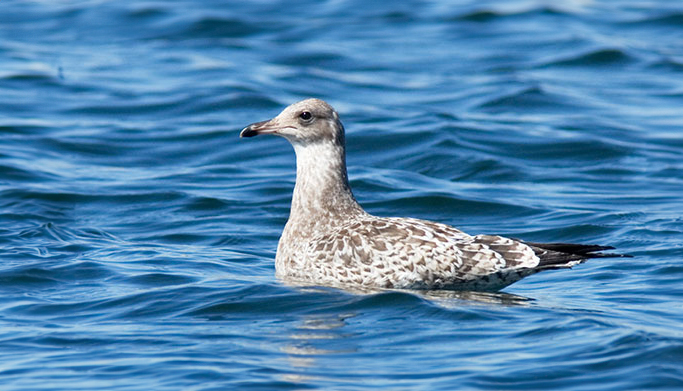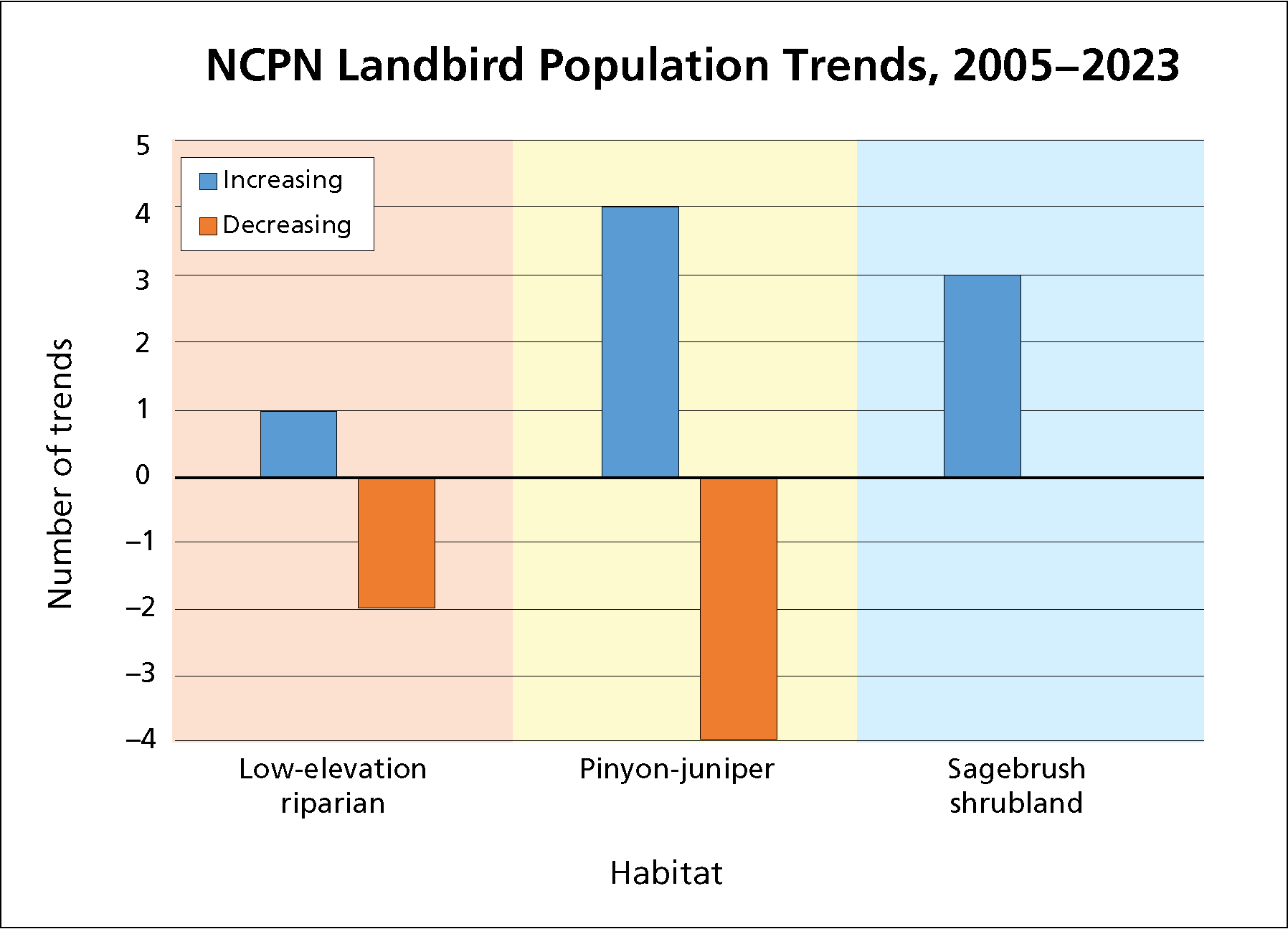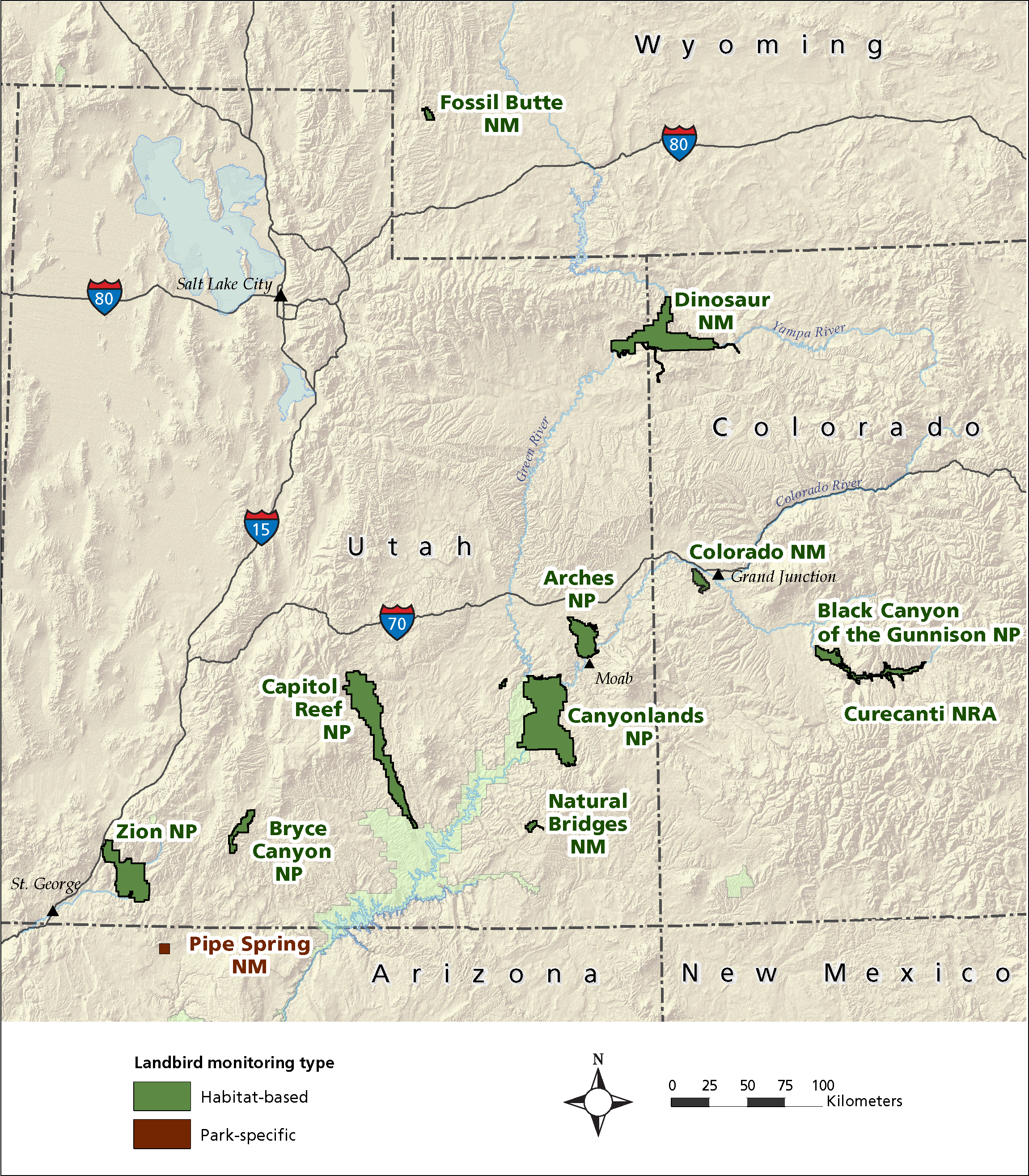Last updated: June 13, 2024
Article
Landbird Population Trends in the Northern Colorado Plateau Network, 2023

Juvenile California gull. Photo courtesy Robert Shantz.
Why Monitor Landbirds?
Birds occupy various levels in the food web and play an important role in the flow of energy through ecosystems. Because they can be sensitive to habitat change, birds are good indicators of ecosystem integrity. Data from the relatively natural habitats of Northern Colorado Plateau Network (NCPN) parks provide status and trend information useful in comparisons with more-impacted areas.
How is the Monitoring Done?
NCPN landbirds monitoring assesses trends in breeding-bird species by habitat, rather than by park. During each breeding season, a partner organization surveys 15 transects in each of the three habitats of interest (low-elevation riparian, pinyon-juniper, and sagebrush shrubland) across 11 network parks. Point counts and area searches are also conducted as part of a modified monitoring design at Pipe Spring National Monument.
What’s the Most Recent News?
Population trends
Over 18 years of data collection, 16,159 point-count surveys have been conducted in the 11 monitored parks, detecting 176 unique species.
Using data from 2005 to 2023, 118 population-density trends were estimated across the three habitats. Fourteen of the estimated density trends were significant (p-value <0.05), including six negative trends and eight positive trends (see chart and table, below). There were sufficient sample sizes to estimate the densities of 61 species in at least one of the three habitats surveyed.

The most recent monitoring showed eight upward trends and six downward trends over time.
Significant trends in landbird species population density across three habitats in 11 NCPN parks, 2023.
| Species | Habitat | ||
|---|---|---|---|
| LR | PJ | SA | |
| Mourning dove | ↓ | ↓ | – |
| White-throated swift | ↓ | ↓ | – |
| Hairy woodpecker | ↑ | NA | NA |
| Bewick's wren | – | ↓ | NA |
| Mountain bluebird | NA | ↓ | – |
| Yellow-rumped warbler | – | ↑ | – |
| Grace's warbler | NA | – | ↑ |
| Vesper sparrow | NA | ↑ | – |
| Lark sparrow | NA | – | ↑ |
| Western tanager | – | ↑ | ↑ |
| Lazuli bunting | – | ↑ | – |
New detections
During the 2023 field season, 599 point-count surveys were conducted, detecting 4,936 individual birds of 118 unique species. Three new species were detected for this monitoring program:
- northern pygmy owl (Glaucidium californicum), Canyonlands National Park,
- sandhill crane (Grus canadensis), Fossil Butte National Monument, and
- California gull (Larus californicus), Fossil Butte National Monument.
In addition, the following birds were detected in the following parks for the first time in this monitoring program:
- cedar waxwing (Bombycilla cedrorum) and peregrine falcon (Falco peregrinus), Arches National Park,
- Townsend’s solitaire (Myadestes townsendi), Canyonlands National Park,
- Cordilleran flycatcher (Empidonax occidentalis), Colorado National Monument,
- Savannah sparrow (Passerculus sandwichensis), Curecanti National Recreation Area,
- osprey (Pandion haliaetus), Dinosaur National Monument, and
- Virginia’s warbler (Leiothlypis virginiae) and Brewer’s blackbird (Euphagus cyanocephalus), Pipe Spring National Monument.
A total of 132 individuals of 34 species were recorded in Pipe Spring National Monument in 2023. Sample sizes were too low for estimation of density trends.
Where are Landbirds Monitored?

Northern Colorado Plateau Network parks where landbirds are monitored.
NCPN landbirds monitoring occurs at 12 network parks: Arches, Black Canyon of the Gunnison, Bryce Canyon, Canyonlands, Capitol Reef, and Zion national parks; Colorado, Dinosaur, Fossil Butte, Natural Bridges, and Pipe Spring national monuments; and Curecanti National Recreation Area (see map).
How is this Information Used?
In order to know which species to manage for, park managers need to know which species are present. Data from this monitoring are also useful for park planning documents, such as Natural Resource Condition Assessments and State of the Park reports, and demonstrate the value of unimpaired national-park landscapes and their value to bird communities.
Results in this brief were summarized from S.G. Roberts, E.L. Tymkiw, Z.S. Ladin, and W.G. Shriver. 2024. Landbird monitoring in the Northern Colorado Plateau Network: 2023 field season. Science Report NPS/SR—2024/138. National Park Service, Fort Collins, Colorado. https://doi.org/10.36967/2304411.
Past Findings
Tags
- arches national park
- black canyon of the gunnison national park
- bryce canyon national park
- canyonlands national park
- capitol reef national park
- curecanti national recreation area
- dinosaur national monument
- fossil butte national monument
- natural bridges national monument
- pipe spring national monument
- zion national park
- landbirds
- animals
- birds
- monitoring
- american southwest
- ecosystem monitoring
- science and resource management
- northern colorado plateau network
- ncpn
- inventory and monitoring division
- natural resource stewardship and science
